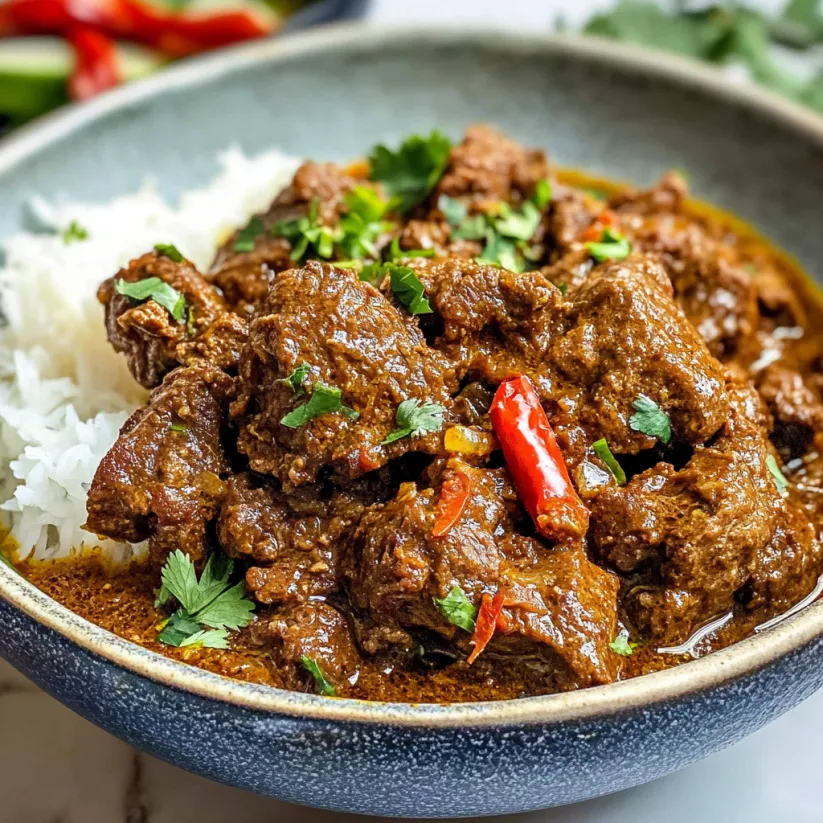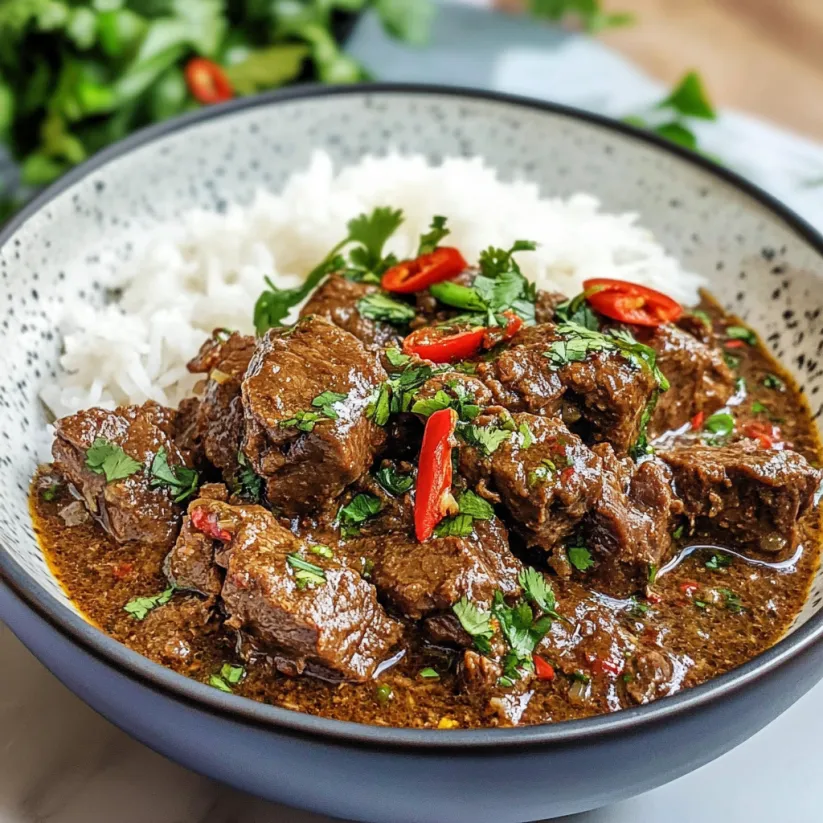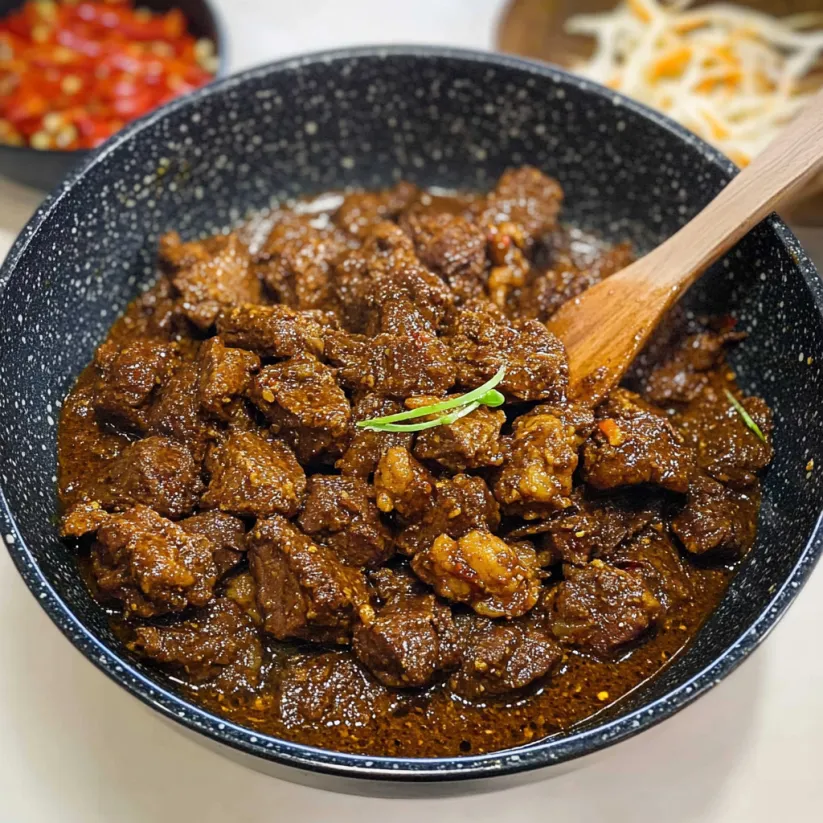 Save Pin
Save Pin
This aromatic beef rendang transforms humble chuck beef into an extraordinary curry through the magic of slow cooking and an intricate blend of spices. The meltingly tender meat bathes in a rich coconut sauce that gradually reduces to create intense flavor in every bite.
I first encountered rendang at a small family restaurant in Bali and spent years trying to recreate that perfect balance of spicy, sweet and savory flavors. This recipe finally captures that elusive taste that transported me back to that unforgettable meal.
Ingredients
- Chuck beef or stewing meat: Tough cuts become incredibly tender through slow cooking while releasing rich flavor into the sauce
- Coconut milk: The foundation of the sauce providing creaminess and subtle sweetness that balances the spices
- Lemongrass: Adds distinctive citrusy fragrance that defines authentic rendang
- Galangal: Similar to ginger but with unique pine and citrus notes essential for authentic flavor
- Kaffir lime leaves: Contributes bright citrus aroma impossible to substitute
- Tamarind paste: Provides the essential sour note that balances the rich coconut
- Shallots: Sweeter and more complex than regular onions creating a more nuanced base flavor
Step-by-Step Instructions
- Prepare the spice paste:
- Process all spice paste ingredients in a food processor until smooth. Take your time here until you achieve a fine paste without any large chunks which ensures the flavors distribute evenly throughout the dish.
- Brown the beef:
- Work in batches to properly sear the beef pieces until golden brown on all sides. This critical step creates a flavor foundation through caramelization that elevates the entire dish. Avoid overcrowding the pan which causes steaming instead of browning.
- Cook the spice paste:
- Sauté the blended spice paste in the same pot for 5 to 7 minutes until extremely fragrant. This cooking process transforms the raw sharpness of the aromatics into deep complex flavors while driving off excess moisture for better texture.
- Combine and simmer:
- Add all remaining ingredients including the browned beef back to the pot and bring to a gentle simmer. The slow three hour cooking process allows the tough collagen in the beef to break down into gelatin while the sauce gradually reduces and intensifies.
- Reduce the sauce:
- Allow the curry to simmer uncovered so moisture can evaporate creating a concentrated sauce. Stir occasionally to prevent sticking especially during the final hour when the sauce thickens considerably.
- Remove whole spices:
- Fish out the cinnamon stick star anise and lemongrass stalks before serving as these inedible aromatics have done their flavor work.
 Save Pin
Save Pin
My Indonesian neighbor taught me the importance of patience with this dish. She explained that rendang was traditionally made to preserve meat before refrigeration existed. The combination of antimicrobial spices and reduced moisture created a dish that could last for weeks at room temperature while developing more complex flavors over time.
Storage and Reheating
Store leftover rendang in an airtight container in the refrigerator for up to 5 days. The flavors actually intensify and meld together beautifully during this time making it an exceptional make ahead dish. For longer storage freeze portions in freezer safe containers for up to 3 months.
When reheating add a small splash of water if the sauce has become too thick and warm gently over low heat. Avoid microwaving which can make the beef tough. Instead reheat slowly on the stovetop allowing the flavors to bloom again as it warms.
Traditional Context
Rendang originated from the Minangkabau people of West Sumatra Indonesia where it holds cultural significance beyond just being delicious food. The dish traditionally appears at ceremonial occasions and celebrations representing the community philosophy of musyawarah where elements come together in harmony through the slow cooking process.
The cooking method reflects Indonesian patience and wisdom about food preparation. As the dish simmers through distinct phases local cooks identify specific stages naneh kalio and finally rendang where the meat and sauce transform from a soupy curry to a dry intensely flavored dish. A properly made rendang balances the six essential flavors in Indonesian cuisine sweet sour salty spicy bitter and umami.
 Save Pin
Save Pin
Serving Suggestions
Steamed jasmine rice serves as the perfect neutral canvas for soaking up the intensely flavorful sauce. For a complete Indonesian meal serve rendang alongside sayur lodeh a vegetable coconut curry sambal a spicy condiment and kerupuk shrimp crackers which add textural contrast.
For a more festive presentation serve family style on a banana leaf lined platter garnished with fresh lime wedges cilantro leaves and thinly sliced red chilies. The bright colors provide beautiful contrast against the dark rich curry.
Commonly Asked Questions
- → What cut of beef works best for Rendang?
Chuck beef or stewing meat works best for Rendang because these cuts contain enough fat and connective tissue that break down during the long cooking time, resulting in tender, flavorful meat. Other suitable cuts include beef brisket, shin or shoulder.
- → Can I make Beef Rendang in advance?
Yes, Beef Rendang actually tastes better when made a day in advance as the flavors have more time to develop. Store it in the refrigerator overnight and gently reheat before serving. Many cooks consider it even more flavorful on the second or third day.
- → What can I substitute for hard-to-find ingredients?
If you can't find galangal, use additional ginger with a pinch of pepper. Dried kaffir lime leaves can replace fresh ones, or substitute with lime zest. For tamarind paste, use lime juice with a touch of brown sugar. Regular onions can replace shallots in a pinch.
- → How can I adjust the spice level?
Control the heat by adjusting the number of red chilies. For a milder version, remove seeds and membranes or reduce the quantity. For extra spice, increase the amount or add Thai bird's eye chilies. You can also add a dash of chili powder to taste during cooking.
- → How do I know when my Beef Rendang is done cooking?
Beef Rendang is done when the meat is fork-tender and easily pulls apart. The sauce should be significantly reduced and darkened, with most of the liquid evaporated, leaving a thick coating around the meat. This typically takes 2-3 hours of gentle simmering.
- → What's the best way to serve Beef Rendang?
Traditionally, Beef Rendang is served with steamed rice. It also pairs well with roti canai (flatbread), nasi lemak (coconut rice), or ketupat (rice cakes). For a complete meal, add sides of cucumber salad, pickled vegetables, or sautéed greens to balance the rich flavors.
